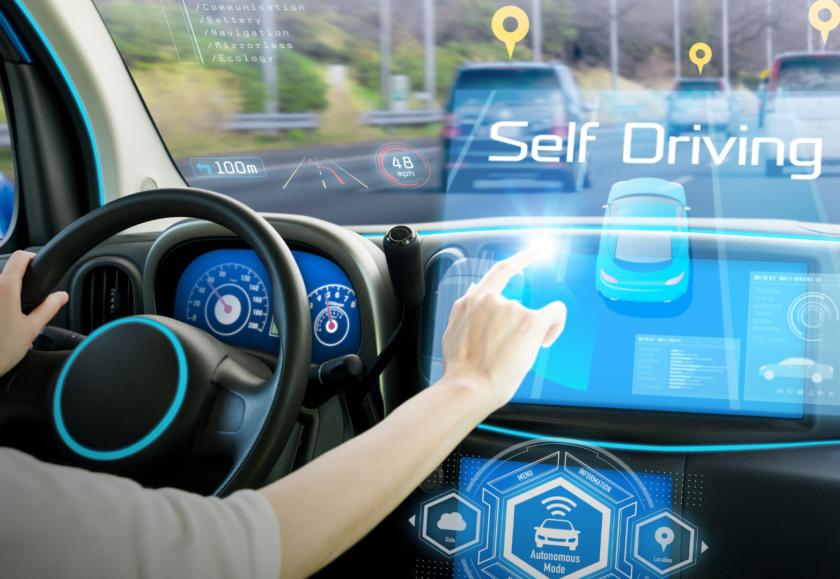Self-driving cars: the future of accessible transport, or a turn for the worse?
Ezra Johnson
Transport for All's Campaigns OfficerSelf-driving cars: a closer look at what could go right, what could go wrong, and what we need to do to make sure that disabled people benefit from technology that’s being built in our name.

Self-driving vehicles are on the horizon. The government wants them on the roads by 2025, and millions of pounds worth of investment is going into making this happen. But what does this mean for disabled people? Could this be the long-awaited solution that finally closes the disability transport gap? Or could the introduction of self-driving cars actually make things worse?
As someone who is unable to drive because of my health condition, the prospect of being able to travel in a driverless car is, upon first thought, exciting to me. Having access to this tech would cut my commute time in half, and I could even have a nap on the way! And for some disabled people who cannot access public transport at all, those who are forced to rely on taxis or other drivers to get around, driverless cars have an even more radical potential to change the way they live.
For years, developers of self-driving cars have traded on this promise as well, flying their projects under the banner of accessibility. Companies have featured disabled people in viral promotional videos, and speculated that autonomous vehicles will enable our community to travel freely without barriers.
It’s an attractive claim, and one that really does have the potential to materialise. If driverless cars are done right, they could revolutionise the way disabled people travel, and open up doors that have been closed to many of us for so long.
But while it is easy to get carried away, this revolution is not guaranteed. And if disabled people aren’t properly centred and directly involved in the development of this technology, and the legislation around it, then the disability transport gap might get worse.
The stakes are high. So, let’s take a closer look at what could go right, what could go wrong, and what we need to do to make sure that disabled people benefit from technology that’s being built in our name.
1. How much are these things going to cost?
When fully self-driving cars hit the market, they are likely to be pretty expensive. This factor alone could put them out of reach for most disabled people. On average, we face £583 a month more living costs than non-disabled people, and are 60% more likely to live in poverty.
These financial barriers to autonomous vehicles are an accessibility issue, and need to be treated as such. This technology cannot change the way disabled people live if we cannot afford to use it, and a small host of affluent disabled people owning self-driving cars will not bring about a meaningful change in the way we live.
In fact, if only a wealthy minority can afford self-driving cars, the disability transport gap could actually increase. A potentially dangerous scenario is one in which autonomous vehicles are available only to a privileged ‘kinetic elite’ who are afforded greater mobility, flexibility, and speed in the world. This would increase the disability transport gap, and compound the social inequalities disabled people already face. Existing literature states clearly that without policy interventions, autonomous vehicles can and will generate equity concerns, and that policy makers need to act as early as possible to identify and protect the interests of disabled people.
2. Will they be safe?
Many advocates claim that self-driving vehicles could radically reduce road traffic accidents by removing human error from the equation. Given that disabled people are five times more likely to be injured by a motor vehicle than non-disabled pedestrians, this could, in theory, benefit us perhaps more than anyone. But once again, there are factors that could make these vehicles acutely unsafe for disabled people if they are not addressed early in the development process.
For one, disabled pedestrians may not be able to move out of the way as quickly as non-disabled people in the event of a malfunction or crash. Blind or visually impaired people may not be able to detect that they are in the vehicles path at all. This needs to be taken into consideration by manufacturers when planning around collision courses, so that disabled people are not disproportionately at risk.
It is also imperative that the sensors on the vehicle are able to recognise disabled people as people: in the event that the vehicle has to choose which way to crash, it must be able to recognise that, say, a person using a power scooter is a pedestrian and not a nonhuman object like a bench, and prioritise their life as much as they would a non-disabled person.
The Law Commission has already investigated this potential bias, pointing out that “systems may not have been trained to deal with the full variety of wheelchairs and mobility scooters.” If the technology isn’t able to recognise all mobility aids, then there is a serious risk that disabled people will be disproportionately injured if this technology hits the roads.
There will need to be ongoing monitoring during the testing and deployment stages of injuries and near misses, assessing if disabled people are disproportionately affected, and which mitigations need to be in place.
3. What impact will self-driving vehicles have on public transport?
There is a lot of (well-founded) fear that the proliferation of self-driving vehicles for private and public use would increase the number of journeys made by car, potentially deterring people from using public transport or other more environmentally friendly modes of travel. There is also concern that funding will be redirected away from affordable and accessible public transport, and instead invested in self-driving private vehicles that are prohibitively expensive.
This cannot be allowed to happen. We must make sure that public transport is not burnt at the altar of self-driving vehicles, and that the promise of an automated and accessible future does not divert funding away from addressing the barriers we face across the rest of the network in the present.
But it doesn’t have to be one or the other. In fact, automated vehicles have the potential to increase access to public transport. Many of the access barriers to the train, metro, bus, etc. exist on the way to and from stations; sometimes the distance is too strenuous, or the pavements broken or obstructed; sometimes there is insufficient parking, or nowhere to store cycles; sometimes taxis drive off if they see a wheelchair user or guide dog handler. If automated vehicles could be used to connect up the journey from door to station, then many more people may be able to use public transport.
Another potential use is within stations. There can be a number of barriers to navigating stations and getting to platforms, especially for people with mobility, visual, or sensory processing impairments. People with energy limiting impairments may also face barriers moving through the station if there is significant distance between platforms, such as on the Elizabeth line. Small self-driving pods that could carry individual passengers through the station may be a way to mitigate these barriers.
There are already a few projects underway with this exact concept in mind. In 2019, Project Synergy trialled the use of self-driving pods to transport passengers from a car park to the terminals of Manchester airport over a distance of 2km.

Initiatives like this that focus on integrating autonomous vehicles into stations and airports are among the most promising developments for disabled people, and could start to change our lives long before fully self-driving cars are ready to hit the roads.
4. What needs to be done to make these accessible for disabled people?
It is absolutely integral that the development of this technology, and the design of any infrastructure and legislation, is coproduced with disabled people. No ifs, ands, or buts. Coproduction should start as early in the process as possible, and should be ongoing from development through to real world testing and policy making. Designs should be coproduced with a range of disabled people from across the impairment groups, who should be compensated for their time and expertise.
This is the only way to ensure that AVs are not only safe and physically accessible, but financially accessible, and deployed in ways that disabled people actually need and want. Without disabled peoples’ involvement in the entire process, the speculative “benefits of increased safety and accessibility to the travelling public” that both government and industry have spoken of for years, will fail to materialise.
Government guidelines on Minimum Engagement for AV trials does not currently specify that Disabled People’s Organisations (DPOs) need to be consulted. The responsibility to consult DPOs should not be at the discretion of private developers, but should be a mandatory part of any trial and rollout.
If public money is being put towards initiatives that promise to change the way disabled people travel, then the government needs to have more robust monitoring and regulation of these projects to ensure that these promises materialise, harms are mitigated against, and that disabled people can see the benefits of money that is being spent in our name.
5. Will self-driving cars help or hinder disabled people?
There is no straight forward answer to this question, and the answer ultimately hinges on how disabled people are involved in the development and rollout of this technology.
Self-driving cars represent a whole host of possibilities for disabled people, and the fact that this has been recognised by developers is encouraging. However, they are not a silver bullet to the disability transport gap. Projects that focus on integrating autonomous vehicles into the existing transport network, rather than overhauling the entire system and replacing it with fleets of self-driving cars, are likely to be more achievable, accessible, and affordable. And if the technology isn’t designed with and for disabled people, then there could be serious risks to our safety and mobility.
Whatever the future of transport looks like, disabled people need to be a part of shaping it today.
Want the latest accessible transport news in your inbox?
Sign up as a member (it’s free!) to receive our newsletter with policy updates, news, as well as opportunities to get involved with our research and campaigns. Click on the link above to visit our membership page and find out more.

